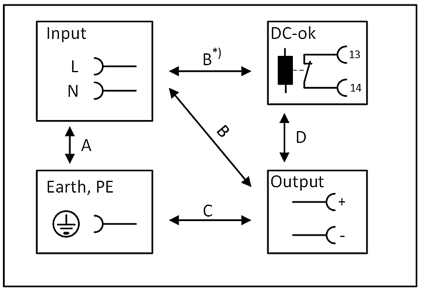Dielectric strength
The output voltage is potential-free and has no resistive connection to earth.
The output is isolated from the input by double or reinforced insulation.
Type and component tests are carried out by the manufacturer. Field tests can be performed in the field using suitable test equipment that ramps up the voltage with a slow ramp (2 s rising and 2 s falling).
- Connect all input terminals and all output poles to each other before performing the tests.
- During the test, set the cut-off current to the value shown in the table below.
- When checking the input to DC-OK (see the following figure. B*)), make sure that the maximum voltage between DC-OK and the output is not exceeded (see column D in the table below). When performing the test, we recommend connecting the DC OK contact pins and the output contact pins.
- We recommend connecting either the positive pole or the negative pole of the output circuit to the protective conductor system. This avoids situations in which the load starts unexpectedly or cannot be disconnected if an unnoticed earth leakage occurs.
 Fig.11: Dielectric strength
Fig.11: Dielectric strength
| A | B | C | D | |
|---|---|---|---|---|---|
Type test | 60 s | 2500 Vac | 3000 Vac | 1000 Vac | 500 Vac |
Component test | 5 s | 2500 Vac | 2500 Vac | 500 Vac | 500 Vac |
Field test | 5 s | 2000 Vac | 2000 Vac | 500 Vac | 500 Vac |
Cut-off current setting for field testing | > 15 mA | > 15 mA | > 20 mA | > 1 mA | |